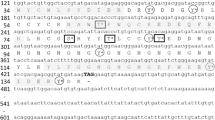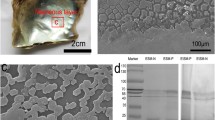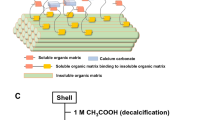Abstract
Considering the continuous and substantive secretory ability of the mantle in vitro, we report a new technique to produce shell-matrix proteins by inducing the mantle, after removal from the organism's body, to secrete soluble-matrix proteins into phosphate buffer. By this method, a large amount of matrix proteins could be obtained in 2 h. Experiments involving in vitro calcium carbonate crystallization and organic framework calcium carbonate crystallization indicated that these proteins retain high bioactivity and play key roles in shell biomineralization. Phosphate buffer–soluble proteins secreted by the margin of the mantles (MSPs) were used to reconstruct the stages in the growth of the prismatic layer of the decalcified organic frameworks. The MSPs were observed to aggregate calcites in vitro, and this ability enabled the mollusk to form big calcites in the prismatic layer. During shell biomineralization, an important stage after the self-assembly of the biomacromolecules and the formation of crystals is the assembly of the two parts to form a firm structure. Moreover, a new type of matrix protein, functioning as the binding factor between the crystals and the organic frameworks, was shown to exist in the phosphate buffer–soluble proteins secreted by the central part of mantles (CSPs). Nanoscale-sized bowl-like aragonites, with heights of ∼800 nm, were induced by CSPs in vitro. This method is a successful example of obtaining functional proteins through secretion by animal tissues.









Similar content being viewed by others
References
Almeida MJ, Milet C, Peduzzi J, Pereira-Mouries L, Haigle J, Barthelemy M, Lopez E (2000) Effect of water-soluble matrix fraction extracted from the nacre of Pinctada maxima on the alkaline phosphatase activity of cultured fibroblasts. J Exp Zool 288:327–334
Atlan G, Delattre O, Berland S, LeFaou A, Nabias G, Cot D, Lopez E (1999) Interface between bone and nacre implants in sheep. Biomaterials 20:1017–1022
Belcher AM, Wu XH, Christensen RJ, Hansma PK, Stucky GD, Morse DE (1996) Control of crystal phase switching and orientation by soluble mollusc-shell proteins. Nature 381:56–58
Checa AG, Rodríguez-Navarro AB, Esteban-Delgado FJ (2005) The nature and formation of calcitic columnar prismatic shell layers in pteriomorphian bivalves. Biomaterials 26:6404–6414
Falini G, Albeck S, Weiner S, Addadi L (1996) Control of aragonite or calcite polymorphism by mollusk shell macromolecules. Science 271:67–69
Fu G, Valiyaveettil S, Wopenka B, Morse DE (2005) CaCO3 biomineralization: acidic 8-kDa proteins isolated from aragonitic abalone shell nacre can specifically modify calcite crystal morphology. Biomacromolecules 6:1289–1298
Gong N, Shangguan J, Liu X, Yan Z, Ma Z, Xie L, Zhang R (2008) Immunolocalization of matrix proteins in nacre lamellae and their in vivo effects on aragonitic tablet growth. J Struct Biol 164:33–40
Hattan SJ, Laue TM, Chasteen ND (2001) Purification and characterization of a novel calcium-binding protein from the extrapallial fluid of the mollusc, Mytilus edulis. J Biol Chem 276:4461–4468
Kono M, Hayashi N, Samata T (2000) Molecular mechanism of the nacreous layer formation in Pinctada maxima. Biochem Biophys Res Commun 269:213–218
Lamghari M, Berland S, Laurent A, Huet H, Lopez E (2001) Bone reactions to nacre injected percutaneously into the vertebrae of sheep. Biomaterials 22:555–562
Lopez E, Vidal B, Berland S, Camprasse S, Camprasse G, Silve C (1992) Demonstration of the capacity of nacre to induce bone formation by human osteoblasts maintained in vitro. Tissue Cell 24:667–679
Lopez E, Milet C, Lamghari M, Pereira-Mouries L, Borzeix S, Berland S (2004) The dualism of nacre. Key Eng Mater 254:733–736
Lowenstam HA, Weiner S (1989) On biomineralizaion. Oxford University Press, New York
Ma Z, Huang J, Sun J, Wang G, Li C, Xie L, Zhang R (2007) A novel extrapallial fluid protein controls the morphology of nacre lamellae in the pearl oyster, Pinctada fucata. J Biol Chem 282:23253–23263
Marin F, Corstjens P, de Gaulejac B, de Vrind-De JE, Westbroek P (2000) Mucins and molluscan calcification: molecular characterization of mucoperlin, a novel mucin-like protein from the nacreous shell layer of the fan mussel Pinna nobilis (Bivalvia, Pteriomorphia). J Biol Chem 275:20667–20675
Moutahir-Belqasmi F, Balmain N, Lieberrher M, Borzeix S, Berland S, Barthelemy M, Peduzzi J, Milet C, Lopez E (2001) Effect of water soluble extract of nacre (Pinctada maxima) on alkaline phosphatase activity and Bcl-2 expression in primary cultured osteoblasts from neonatal rat calvaria. J Mater Sci Mater Med 12:1–6
Samata T, Hayashi N, Kono M, Hasegawa K, Horita C, Akera S (1999) A new matrix protein family related to the nacreous layer formation of Pinctada fucata. FEBS Lett 462:225–229
Silve C, Lopez E, Vidal B, Smith DC, Camprasse S, Camprasse G, Couly G (1992) Nacre initiates biomineralization by human osteoblasts maintained in vitro. Calcif Tissue Int 51:363–369
Smith BL, Schäffer TE, Viani M, Thompson JB, Frederick NA, Kindt J, Belcher A, Stucky GD, Morse DE, Hansma PK (1999) Molecular mechanistic origin of the toughness of natural adhesives, fibres and composites. Nature 399:761–763
Sudo S, Fujikawa T, Nagakura T, Ohkubo T, Sakaguchi K, Tanaka M, Nakashima K (1997) Structures of mollusc shell framework proteins. Nature 387:563–564
Suzuki M, Saruwatari K, Kogure T, Yamamoto Y, Nishimura T, Kato T, Nagasawa H (2009) An acidic matrix protein, Pif, is a key macromolecule for nacre formation. Science 325:1388–1390
Weiner S, Hood L (1975) Soluble protein of the organic matrix of mollusk shells: a potential template for shell formation. Science 190:987–989
Weiner S, Addadi L (1991) Acidic macromolecules of mineralized tissues: the controls of crystal formation. Trends Biochem Sci 16:252–256
Weiss IM, Kaufmann S, Mann K, Fritz M (2000) Purification and characterization of perlucin and perlustrin, two new proteins from the shell of the mollusk Haliotis laevigata. Biochem Biophys Res Commun 267:17–21
Wheeler AP, George JW, Evans CA (1981) Control of calcium carbonate nucleation and crystal growth by soluble matrix of oyster shell. Science 212:1397–1398
Zhang C, Li S, Ma Z, Xie L, Zhang R (2006) A novel matrix protein p10 from the nacre of pearl oyster (Pinctada fucata) and its effects on both CaCO3 crystal formation and mineralogenic cells. Mar Biotechnol 8:624–633
Acknowledgments
This work was supported by the National High Technology Research and Development Program of China (2010CB126405; 2010AA09Z405), the National Natural Science Foundation of China (U0831001).
Author information
Authors and Affiliations
Corresponding authors
Rights and permissions
About this article
Cite this article
Liu, X., Liu, C., Chen, L. et al. A New Method to Extract Matrix Proteins Directly from the Secretion of the Mollusk Mantle and the Role of These Proteins in Shell Biomineralization. Mar Biotechnol 13, 981–991 (2011). https://doi.org/10.1007/s10126-011-9362-y
Received:
Accepted:
Published:
Issue Date:
DOI: https://doi.org/10.1007/s10126-011-9362-y




